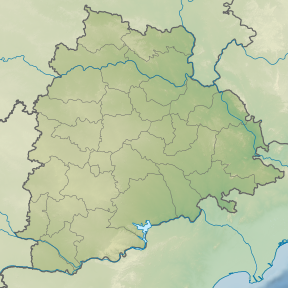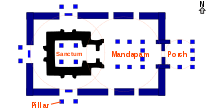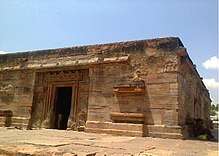Alampur Navabrahma Temples
Alampur Navabrahma Temples are a group of nine early Chalukyan Hindu temples dated to 7th-century that are located at Alampur in Telangana, near the meeting point of Tungabhadra River and Krishna River at the border of Andhra Pradesh.[1] They are called Nava-Brahma temples though they are dedicated to Shiva. They exemplify early North Indian Nagara style architecture with cut rock as the building block.[1]
| Alampur Navabrahma Temples | |
|---|---|
Svarga Brahma Temple | |
| Religion | |
| Affiliation | Hinduism |
| District | Jogulamba Gadwal district |
| Deity | Shiva, others |
| Location | |
| Location | Alampur |
| State | Telangana |
| Country | India |
 Location in Telangana  Alampur Navabrahma Temples (Telangana) | |
| Geographic coordinates | 15°52′40.1″N 78°08′5.4″E |
| Architecture | |
| Style | Nagara |
| Completed | 7th century |
| Temple(s) | 9 |
The temples are significant for their east-facing simple square plans, intricate carvings of themes of Shaivism, Vaishnavism and Shaktism. They also contain early examples of friezes that narrate legends from Hindu texts such as the Panchatantra fables.[2] The temples were a significant influence on the later era Kakatiya Hindu temples.[3]
The Alampur Navabrahma temples were badly damaged and some razed to the ground during the Islamic invasion of this region in 1390.[4] They were built by the Badami Chalukyas rulers, and early 8th-century inscriptions found at the site suggest that the site also had a Shaiva matha (Hindu monastery) which has not survived.[5] Their ruins have been restored by the Archaeological Survey of India after 1980.[4][6]
Location
The Alampur Navabrahma temples are located in the Telangana town of Alampur, close to the Tungabhadra river. It is 215 kilometres (134 mi) south of Hyderabad, connected by the four-lane National Highway 44 (Asian Highway 43), and about 240 kilometres (150 mi) northeast of Hampi monuments and 325 kilometres (202 mi) east of Badami, the capital of the kings who are credited with building it in the 7th century.[1]
History
Sangameshwara Temple
The Sangameshwara Temple was originally built at Kudavelly, by the confluence (sangam) of two major sacred rivers of ancient importance, the Tungabhadra and Krishna.[1] Sangameshwara comes from the word Sangam meaning confluence of two or more rivers. The Sangameshwara Temple was constructed by Pulakesi I ( 540 CE to 566 CE), in a similar style to the Navabrahma Temples. Based on inscriptional evidence such as the Tummayaneru grant, Sarma dates the temple to pre-Chalukya era when Navabrahma temples were built.[7] Odile Divakaran states that the Sangameshwara temple at Kudaveli was not an earlier monument, but was built along with the nine Navabrahma temples, likely in the middle of the 7th-century.[8] According to Sarma, new inscriptions found in the 1980s at the Arka Brahma and Bala Brahma temples mention a pre-existing mahadevayatana or main temple with linga, the Sangameshwara Temple.[7]
The Sangameshwara Temple has been moved to near the Navabrahma temples, as its original site built at Kudavelly, some 20 km away, is now flooded by the Srisailam Dam hydroelectric project. The Sangameshwara temple transplantation was completed by January 1990.[7]
Navabrahma temples
As the Badami Chalukyan kingdom became well established, its rulers sponsored the distinct Badami Chalukya architecture style of Hindu temple architecture in Aihole, Badami, Alampur and later Pattadakal. The nine temples at this site reflect some of the early Nagara style of Hindu temples that have partially survived for scholarly studies.[9][10] The uniqueness of this group of temples lies in their plan and design in the northern architectural style introduced by the Chalukyas of Badami in the 7th century.
ASI protection and relocation
The Alampur temples are listed as an archaeological and architectural treasure on the official "List of Monuments" prepared by the Archaeological Survey of India under The Ancient Monuments and Archaeological Sites and Remains Act.[11] Some temples at the Alampur site came under submergence due to the building of Sri Sailam Hydro-electric Project, the threatened ancient and medieval era monuments along with the Sangameshwara temple were relocated to a higher place, west and southwest of the Navabrahma temples.[12][13] The latter was transplanted near the Alampur Papanasi Temples.
Description
The temples are emblematic of the Northern Indian Nagara style of architecture.[1] The Navabrahma temples are present on the left bank of the Tungabhadra River, enclosed in a courtyard.[14]
The temples have a square plan that follow the vastupurushamandala architecture. A square sanctum is surrounded by a covered circumambulation path and a Rekha-nagara style curvilinear square shikara towers above the sanctum of each temple. The tower is capped by an amla and a kalasha, though in some cases this has not survived. In front of each sanctum is a mandapa.[15]
- Taraka Brahma: This is an unusual early stage Hindu temple because it has a multistorey tower and for carving deities into the ceiling, suggesting that the artisans were experimenting and exploring novel construction ideas in stone temples by the 7th-century.[15][16] This temple, as others, incorporates 6th-7th century CE Telugu and Kannada inscriptions.

- Svarga Brahma: Swarga Brahma temple was built during 681-696 AD or the Vinayaditya era.[18] An inscription found in the temple states that Lokaditya Ela Arasa built it in the honour of the queen. It is an example of Badami Chalukya Architecture and sculpture. This temple is the most elaborately ornamented temple.[16][18] Its square plan is simple, and it includes a mukhachatuski, a gudhamandapa, an antarala and a garbhagriya.[17][18] It has a porch in front with fluted shafts and foliage motifs. It has a pair of dikpalas (directional guardians) in each corner of the temple. The temple shows two Nataraja (dancing Shiva), one Lingobhava (Shiva emerging from a linga), one Dakshinamurti (Shiva in yoga position as a teacher sitting under a tree). The temple also has common life scenes, as well as amorous couples in various stages of courtship and kama.[16][18] The temple has friezes showing four fables from the Panchatantra, along with a Sanskrit inscription below that summarizes the moral of each fable.[19][18] One of its niches has a sculpture narrating the Vamana-Trivikrama legend of Vishnu.[20]
- Padma Brahma is probably the last temple to be built in the group, one with an incomplete tower rather than a destroyed tower structure. It has no entrance porch, but displays the most complex pediment designs.[16] Padma Brahma temple has a polished stone sculpture of Shivalinga.
- Bala Brahma: As per the inscriptions, Bala Brahma temple dates back to 702 CE. The temple has Shaktism themes represented with the sculptures of Saptamatrikas (seven mothers).[16] It is an active house of Hindu worship in contemporary times. Shivaratri is celebrated in this temple every year.
- Garuda Brahma has the same plan as the Vishwa Brahma temple, but it lacks the latter's intricate carving. It includes a flying Garuda, the vahana of Vishnu, suggestive of the likelihood that the temple once included a sculpture of Vishnu.[16]
- Kumara Brahma is probably the earliest temple built, and like others stands on a jagati (platform).[21] The outer walls provide a perforated screen to let natural light come into the circumambulation path. The pillars and beams in the ceiling are all carved with miniature figures and mayura (peacock) motifs.[16] The tower is divided into venukosha, uccheda and madhyalata, with the Sikhara of tribhuni class of design. The pillars inside the mandapa have amorous couples in mithuna scenes. The sanctum doorway is flanked by Ganga and Yamuna goddesses, as well as two dvarapalas.[21]

- Arka Brahma temple is a mostly ruined temple.[16] The temple art has been defaced, with only remnants of Ganga and Yamuna goddesses visible on the entrance of the sanctum. There is an inscription in the Siddhamatrika script which in most cases are likely the names of the artists who worked on specific sculpture (now missing), and these are in Kannada and Telugu languages.[22]
- Vishva Brahma temple is an intricately carved temple with its niches and windows featuring complex designs around them. The foundational platform is also carved with musicians, dancers, foliage, birds, geese and ganas. The temple pillars inside the mandapa have fluted shafts above seated lions, while the capital is ribbed kalasha shaped.[16] The temple also has sculptural scenes from the Hindu epics as well as the Panchatantra.[23]
- Vira Brahma temple is the northmost temple in the group. It has a gudha-mandapa, antarala and a garbhagriya.[24] The outer walls of the temple are sectioned by pairs of pilasters into projecting niches but the artwork in these have not survived. The tower above the sanctum has projections in its center.[16]
There is an ASI museum near this group of temples. It shows ruins recovered at the site, with remnants of a Durga in Mhishasura-mardini form, a Lajja-Gauri, a Nataraja Shiva which George Michell calls a "masterpiece of refined sculpture", a polished Nandi statue with Shiva and Parvati riding it.[15][16] The museum also has ruins of reliefs that narrate Hindu epics and other texts such as the Panchatantra.[25]
Nearby temples
Alampur was an important pilgrimage site for the Hindus well after the 8th century as evidenced by the inscriptions and nearby major complex of temples. The Papanasam group of Hindu temples built in the 9th and 10th centuries are about 1.5 kilometres (0.93 mi) southwest from the Navabrahma temple site.[15][16] There are other temples like Suryanarayana temple dating back to 9th century. The Narasimha temple has inscriptions from the Sri Krishna Devaraya (Vijayanagar Empire) era.[26]
See also
References
- George Michell (2013). Southern India: A Guide to Monuments Sites & Museums. Roli Books. pp. 318–321. ISBN 978-81-7436-903-1.
- Marijke J. Klokke (2000). Narrative Sculpture and Literary Traditions in South and Southeast Asia. BRILL. pp. 78–82. ISBN 90-04-11865-9.
- Madhusudan A. Dhaky; American Institute of Indian Studies (1996). Encyclopaedia of Indian temple architecture. American Institute of Indian Studies. pp. 423, 447. ISBN 978-81-86526-00-2.
- "Alampur surfaces after six days". The Hindu. 8 October 2009.
- B. Rajendra Prasad (1983). Chalukyan Temples of Andhradesa. Abhinav Publications. pp. 8–9. ISBN 978-0-391-02853-1.
- ASI yet to assess damage to Kurnool structures - Times Of India
- IK Sarma (2000). Harsh K. Gupta (ed.). Deccan Heritage. Universities Press. pp. 169–192. ISBN 978-81-7371-285-2.
- Odile Divakaran (1971), Les temples d'Ālampur et de ses environs au temps des Cāḷukya de Bādāmi, Arts Asiatiques, Vol. 24, No. 1, pp. 72-73
- Marijke J. Klokke (2000). Narrative Sculpture and Literary Traditions in South and Southeast Asia. BRILL. pp. 94–95. ISBN 90-04-11865-9.
- B. Rajendra Prasad (1983). Chalukyan Temples of Andhradesa. Abhinav Publications. pp. 12–29. ISBN 978-0-391-02853-1.
- "Alphabetical List of Monuments - Andhra Pradesh". Archaeological Survey of India. Archived from the original on 25 June 2014. Retrieved 27 November 2017.
- N. L. Batra (1996). Heritage conservation: preservation and restoration of monuments. Aryan. p. 39. ISBN 978-81-7305-108-1.
- Government of Andhra Pradesh (2004). Alampur, Mahboobnagar District, Andhra Pradesh. Government of Andhra Pradesh Publications. p. 92.
- "Archived copy". Archived from the original on 3 April 2016. Retrieved 14 June 2016.CS1 maint: archived copy as title (link)
- Odile Divakaran (1971), Les temples d'Ālampur et de ses environs au temps des Cāḷukya de Bādāmi, Arts Asiatiques, Vol. 24, No. 1, pp. 51-101
- George Michell (2013). Southern India: A Guide to Monuments Sites & Museums. Roli Books. pp. 319–320. ISBN 978-81-7436-903-1.
- George Michell (1977). The Hindu Temple: An Introduction to Its Meaning and Forms. University of Chicago Press. pp. 66–67. ISBN 978-0-226-53230-1.
- B. Rajendra Prasad (1983). Chalukyan Temples of Andhradesa. Abhinav Publications. pp. 23–27. ISBN 978-0-391-02853-1.
- Marijke J. Klokke (2000). Narrative Sculpture and Literary Traditions in South and Southeast Asia. BRILL Academic. pp. 81–82. ISBN 90-04-11865-9.
- James C. Harle (1994). The Art and Architecture of the Indian Subcontinent. Yale University Press. pp. 185–187 with Figure 140. ISBN 978-0-300-06217-5.
- B. Rajendra Prasad (1983). Chalukyan Temples of Andhradesa. Abhinav Publications. pp. 12–15. ISBN 978-0-391-02853-1.
- B. Rajendra Prasad (1983). Chalukyan Temples of Andhradesa. Abhinav Publications. pp. 16–17. ISBN 978-0-391-02853-1.
- Marijke J. Klokke (2000). Narrative Sculpture and Literary Traditions in South and Southeast Asia. BRILL Academic. pp. 78–79. ISBN 90-04-11865-9.
- B. Rajendra Prasad (1983). Chalukyan Temples of Andhradesa. Abhinav Publications. pp. 17–20. ISBN 978-0-391-02853-1.
- Marijke J. Klokke (2000). Narrative Sculpture and Literary Traditions in South and Southeast Asia. BRILL Academic. pp. 94–95. ISBN 90-04-11865-9.
- B. Rajendra Prasad (1983). Chalukyan Temples of Andhradesa. Abhinav Publications. pp. 17–29. ISBN 978-0-391-02853-1.
Bibliography
- Prasanna Kumar Acharya (2010). An encyclopaedia of Hindu architecture. Oxford University Press (Republished by Motilal Banarsidass). ISBN 978-81-7536-534-6.
- Prasanna Kumar Acharya (1997). A Dictionary of Hindu Architecture: Treating of Sanskrit Architectural Terms with Illustrative Quotations. Oxford University Press (Reprinted in 1997 by Motilal Banarsidass). ISBN 978-81-7536-113-3.
- Vinayak Bharne; Krupali Krusche (2014). Rediscovering the Hindu Temple: The Sacred Architecture and Urbanism of India. Cambridge Scholars Publishing. ISBN 978-1-4438-6734-4.
- Alice Boner (1990). Principles of Composition in Hindu Sculpture: Cave Temple Period. Motilal Banarsidass. ISBN 978-81-208-0705-1.
- Alice Boner; Sadāśiva Rath Śarmā (2005). Silpa Prakasa. Brill Academic (Reprinted by Motilal Banarsidass). ISBN 978-8120820524.
- A.K. Coomaraswamy; Michael W. Meister (1995). Essays in Architectural Theory. Indira Gandhi National Centre for the Arts. ISBN 978-0-19-563805-9.
- Dehejia, V. (1997). Indian Art. Phaidon: London. ISBN 0-7148-3496-3.
- Adam Hardy (1995). Indian Temple Architecture: Form and Transformation. Abhinav Publications. ISBN 978-81-7017-312-0.
- Adam Hardy (2007). The Temple Architecture of India. Wiley. ISBN 978-0470028278.
- Adam Hardy (2015). Theory and Practice of Temple Architecture in Medieval India: Bhoja's Samarāṅgaṇasūtradhāra and the Bhojpur Line Drawings. Indira Gandhi National Centre for the Arts. ISBN 978-93-81406-41-0.
- Harle, J.C., The Art and Architecture of the Indian Subcontinent, 2nd edn. 1994, Yale University Press Pelican History of Art, ISBN 0300062176
- Monica Juneja (2001). Architecture in Medieval India: Forms, Contexts, Histories. Orient Blackswan. ISBN 978-8178242286.
- Stella Kramrisch (1976). The Hindu Temple Volume 1. Motilal Banarsidass (Reprinted 1946 Princeton University Press). ISBN 978-81-208-0223-0.
- Stella Kramrisch (1979). The Hindu Temple Volume 2. Motilal Banarsidass (Reprinted 1946 Princeton University Press). ISBN 978-81-208-0224-7.
- Michael W. Meister; Madhusudan Dhaky (1986). Encyclopaedia of Indian temple architecture. American Institute of Indian Studies. ISBN 978-0-8122-7992-4.
- George Michell (1988). The Hindu Temple: An Introduction to Its Meaning and Forms. University of Chicago Press. ISBN 978-0-226-53230-1.
- George Michell (2000). Hindu Art and Architecture. Thames & Hudson. ISBN 978-0-500-20337-8.
- T. A. Gopinatha Rao (1993). Elements of Hindu iconography. Motilal Banarsidass. ISBN 978-81-208-0878-2.
- Ajay J. Sinha (2000). Imagining Architects: Creativity in the Religious Monuments of India. University of Delaware Press. ISBN 978-0-87413-684-5.
- Burton Stein (1978). South Indian Temples. Vikas. ISBN 978-0706904499.
- Burton Stein (1989). The New Cambridge History of India: Vijayanagara. Cambridge University Press. ISBN 978-0-521-26693-2.
- Burton Stein; David Arnold (2010). A History of India. John Wiley & Sons. ISBN 978-1-4443-2351-1.
- Kapila Vatsyayan (1997). The Square and the Circle of the Indian Arts. Abhinav Publications. ISBN 978-81-7017-362-5.
External links
- Ten Mahishasuramardani Icons from Alampur, M Radhakrishna Sharma
- Doorframes on the Earliest Orissan Temples, Thomas Donaldson

